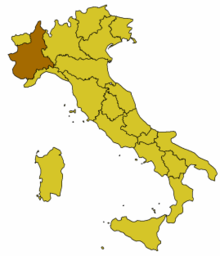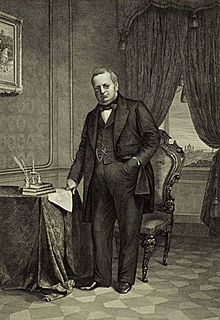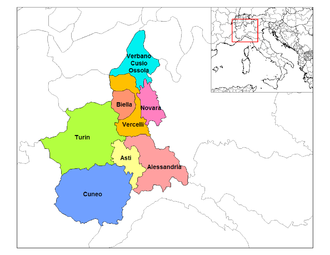- Piemonte (wine)
-
Piemonte wine is the range of Italian wines made in the province of Piedmont in the northwestern corner of Italy. The best-known wines from the region include Barolo and Barbaresco. They are made from the Nebbiolo grape. These wines are ideal for storage and a well-aged Barolo for instance may leave a feeling of drinking velvet because the tannins are polished and integrated more and more into the wine. As the wine matures the colour becomes more brownish and rust-red.
Other popular grapes used for red wine production are Barbera and Dolcetto. Wine made on the Barbera grape is often fruity and delicate with less tannin than wine made from the Nebbiolo grape. Dolcetto on the other side, is not as the name indicates sweet (dolce is Italian for sweet). The grape gives fresh and dry red wines with some tannin. The wines made on the Dolcetto grape should be consumed young.
The sparkling wine Asti is made from the Moscato grape. The majority of the area's winemaking take places in the provinces of Cuneo, Asti and Alessandria. The Brachetto is another variety used for making sweet and sparkling red wines.
While Turin is the capital of the Piedmont, Alba and Asti are at the heart of the region's wine industry. The wine making industry of the Piedmont played a significant role in the early stages of the Risorgimento with some of the era's most prominent figures-like Camillo Benso, conte di Cavour and Giuseppe Garibaldi owning vineyards in Piedmont region and making significant contributions to the development of Piedmontese wines. The excessively high tariffs imposed by the Austrian Empire on the export of Piedmontese wines to Austrian controlled areas of northern Italy was one of the underlying sparks to the revolutions of 1848–1849.
Contents
History
Like in most of Italy, native vines are abundant in the land that the Ancient Greeks called Oenotrua (meaning "land of vines") and was subsequently cultivated by the Romans. With its close proximity, France has been a significant viticultural influence on the region, particularly Burgundy, which is evident today in the varietal styles of most Piedmontese wines with very little blending. One of the earliest mention of Piedmontese wines occurred in the 14th century when the Italian agricultural writer Pietro de Crescentius wrote his Liber Ruralium Commodorum. He noted the efforts of the Piedmontese to make "Greek style" sweet wines by twisting the stems of the grapes clusters and letting them hang longer on the vine to dry out. He also noted the changes with trellising in the region with more vines being staked close to the grounds rather than cultivated high among trees in the manner more common to Italian viticulture at the time. In the 17th century, the court jeweller of Charles Emmanuel I, Duke of Savoy earned broad renown for his pale red Chiaretto made entirely from the Nebbiolo grape.[1]
During the Risorgimento (Italian unification) of the 19th century, many Piemontese winemakers and land owners played a pivotal role. The famous Italian patriot Giuseppe Garibaldi was a winemaker who in the 1850s introduced the use of the Bordeaux mixture to control the spread of oidium that was starting to ravage the area's vineyards. Camillo Benso, conte di Cavour was a wealthy vineyard owner who went abroad to study advance viticulture prior to founding the political newspaper Il Risorgimento. He was highly influential in the adoption of many French viticultural techniques among the Piemontese vineyards.[1]
 King Charles Albert of Sardinia
King Charles Albert of Sardinia
One of the early sparks of the Italian revolts against Austria was the act of the Austrian government to double the tariffs of Piemontese wines into the Austrian control lands of Lombardy, Emilia and the Veneto. This had a crippling effect on the Piemontese wine industry, essentially cutting them off from their main export market. In 1846, King Charles Albert of Sardinia spoke to the Piedmontese winegrowers at the meeting of the Agricultural Congress at Casale Monferrato where he assailed the Austrian oppression. By 1848, Piedmont was at war with Austria in one of the early events that eventually led to the unification of the Italian peninsula under the rule of Charles Albert's son Victor Emmanuel.[1]
Climate and geography
The Piedmont region is located in the foothills of the Alps forming its border with France and Switzerland. To the northwest is the Valle d'Aosta, to the east is the province of Lombardy with the Liguria region forming its southern border along the Apennines. In addition to the vast mountainous terrain, the Po Valley consumes a large area of available land-leaving only 30% of the region suitable for vineyard plantings. The valley and the mountains do contribute to the areas noted fog cover which aides in the ripening of the Nebbiolo grape (which gets it name from the Piedmontese word nebbia meaning "fog").[2]
Although the winemaking regions of the Piedmont and Bordeaux are very close in latitude, only the summertime temperatures are similar: the Piedmont wine region has a colder, continental winter climate, and significantly lower rainfall due to the rain shadow effect of the Alps.[3][4] Vineyards are typically planted on hillsides altitudes between 490–1150 ft (150-400 metre). The warmer south facing slopes are mainly used for Nebbiolo or Barbera while the cooler sites are planted with Dolcetto or Moscato.[5]
Regions
The majority of the region's winemaking (about 90%) takes place in the southern part of Piedmont around the towns of Alba (in Cuneo), Asti and Alessandria.[2] The Piemonte wine region is divided into five broad zones.[5]
- Canavese - includes the areas around Turin such as Carema and Caluso
- Colline Novarese - includes the province of Novara
- Coste della Sesia - includes the area around Vercelli
- Langhe - includes the hill country around the city of Alba and the Roero.
- Monferrato - includes the areas around Asti and Alessandria
DOCs
The Piedmont region is home to 45 Denominazione di origine controllata (DOC) and 12 Denominazione di Origine Controllata e Garantita (DOCG).[6]
The 12 DOCG wines in Piedmont are:
- Asti
- Barbaresco
- Barbera d'Asti
- Barbera del Monferrato Superiore
- Barolo
- Acqui
- Dogliani
- Ovada
- Gattinara
- Gavi
- Ghemme
- Roero
Grapes and wines
Barbera is the most widely-planted grape in the region, but Nebbiolo and Dolcetto account for a significant portion of the area's red wine production as well. With white wines, Moscato is the most prominent with its sparkling and frizzante style wines. Other notable white wines include styles made from the Cortese grape in Gavi as well as blends of Cortese with Arneis and Favorita from Colli Tortonesi and Alto Monferrato. Since the 1980s there has been growing numbers of experimental plantings with the international varieties of Cabernet Sauvignon, Chardonnay, Merlot, Pinot noir, Sauvignon blanc and Syrah.[5] Other local or indigenous grapes include Bonarda, Croatina, Erbaluce, Freisa, Grignolino, Malvasia Nera, Pelaverga and Vespolina.[2]
The Piedmont produces more DOC/G wines by volume than any other Italian wine region with nearly 84% of all the areas wine production falling under a DOC/G designation. The area has no Indicazione Geografica Tipica (IGT) classification, in contrast to Tuscany where IGT wines or Super Tuscans make up a significant portion of that region's wine production.[2]
Some varietal style wines are made in the Piedmont region with the name of the grape and town both appearing on the label. Some DOC examples include Barbera d'Alba, Barbera d'Asti, and Dolcetto di Dogliani made entirely from the Barbera and Dolcetto grape respectively.[7]
Barolo
In 1980, the wines of the Barolo region became one of the first Italian wines to receive DOCG status. Produced to the southwest of the town of Alba in the hills of the Langhe, Barolo is a big, tannic expression of the Nebbiolo grape. The soil of this area is a composition of clay and marl which helps to lessen the naturally high acidity of Nebbiolo. The Tanaro river flows through the heart of Barolo country and serves as a tempering influence on the region's summertime heat till harvest time in late October/mid November. A small wine region, extending over 7 miles in length and 5 miles at its widest point, Barolo produces about 500,000 cases of wine annually. Nearly 87% of the zone productions comes from vineyards in five communities.[8]
Wines from the Central Valley of La Morra and Barolo tend to be very perfumed and velvety with less tannins than other Barolos. The soil of the Central Valley itself is more clay based with increased levels of magnesium oxide and manganese. The wines from the Serralunga Valley are more full bodied and tannic and require aging of 12–15 years before they hit their peak. The soil of the Serralunga is heavy in sand, iron, limestone, phosphorus and potassium.[8]
Barbaresco
Being produced from the same grape as Barolo and less than 10 miles apart, there are a lot of similarities that Barbaresco has with it neighboring wines but the slight maritime influence of the Tanaro river helps fashion distinctly different wines. Generally less tannic, Barbaresco tend to be more elegant and approachable in their youth. The Barbaresco DOCG regulation stipulates wines with minimum alcohol content of 12.5% and 2 years minimum aging in the winery for standard labels and 4 years minimum for riservas wines. Being an even smaller zone then Barolo, producers in the region produce a little more than 200,000 cases annually. The majority of Barbaresco production takes place in 3 communities.[9]
The soils in the Barbaresco zone are more uniform across the region which tends to produce a more consistent profile with the wines then what could be achieved across the widely different areas of Barolo.[9]
Moscato d'Asti
See also: Asti (wine)The white wines made from the Moscato Bianco (also known as Muscat Blanc à Petits Grains) are most noted for their frizzante and sparkling spumante styles but some still wines are produced as well. Located northeast of Alba, the wines from the Asti region are known for their delicate light bodies, low alcohol content and slightly sweet nature.[10] Like many sparkling wines, Asti are not vintage dated even though a majority of the grapes might all come from the same vintage year. The wines are typically at their peak between 1 and 2 years from their release.[11]
Other wines
The Barbera grape is the most widely planted variety in all of the Piedmont and makes a juicy, muscular red wine that is not as tannic as Barolo and Barbaresco. It is grown in nearly every major wine making region of the Piedmont but seems to do best near the towns of Alba and Asti. Some producers are experimenting with blending Barbera with Nebbiolo to combine the former's fruitiness with the later's structure. The light fruitiness of wines from the Dolcetto grape has caused some wine writers to describe it as the Italian version of Beaujolais. The wines have a sense of spiciness to them with little acid and tannins. They are able to be drunk relatively young and tend to be the every day drinking wines of the Piedmontese.[12]
Up until the 1980s, when the wines of the Friuli-Venezia Giulia began to receive notice, the white wines of the Gavi region were touted as the best expression of dry Italian wine. Made primarily from the Cortese grape, these wines are noted for their dry, crisp acidity with citrus and mineral notes. The white wines made from the Arneis grape tend to be dry, vibrant and full body with notes of pears and apricots. Produced in the hills of the Roero to the northwest of Alba, the name Arneis means "rascal" in Piedmontese.[12]
See also
- Piedmont
- Piedmont cuisine
External links
References
- ^ a b c H. Johnson Vintage: The Story of Wine pg 412-423 Simon and Schuster 1989 ISBN 0-671-68702-6
- ^ a b c d M. Ewing-Mulligan & E. McCarthy Italian Wines for Dummies pg 38-41 Hungry Minds 2001 ISBN 0-7645-5355-0
- ^ San Damiano d'Asti climate http://www.weatherbase.com/weather/weather.php3?s=161161&refer=&units=metric
- ^ Bordeaux climate http://www.weatherbase.com/weather/weather.php3?s=1570&refer=&units=metric
- ^ a b c J. Robinson (ed) "The Oxford Companion to Wine" Third Edition pg 525-526 Oxford University Press 2006 ISBN 0-19-860990-6
- ^ Denominazione_di_Origine_Controllata_e_Garantita#Elenco_di_vini_DOCG
- ^ M. Ewing-Mulligan & E. McCarthy Italian Wines for Dummies pg 52 Hungry Minds 2001 ISBN 0-7645-5355-0
- ^ a b M. Ewing-Mulligan & E. McCarthy Italian Wines for Dummies pg 42-46 Hungry Minds 2001 ISBN 0-7645-5355-0
- ^ a b M. Ewing-Mulligan & E. McCarthy Italian Wines for Dummies pg 47-51 Hungry Minds 2001 ISBN 0-7645-5355-0
- ^ K. MacNeil The Wine Bible pg 327 Workman Publishing 2001 ISBN 1-56305-434-5
- ^ M. Ewing-Mulligan & E. McCarthy Italian Wines for Dummies pg 62 Hungry Minds 2001 ISBN 0-7645-5355-0
- ^ a b K. MacNeil The Wine Bible pg 331-333 Workman Publishing 2001 ISBN 1-56305-434-5
Categories:- Wines of Piedmont
- Wine regions of Italy
- Piedmont
- Piedmontese cuisine
Wikimedia Foundation. 2010.



